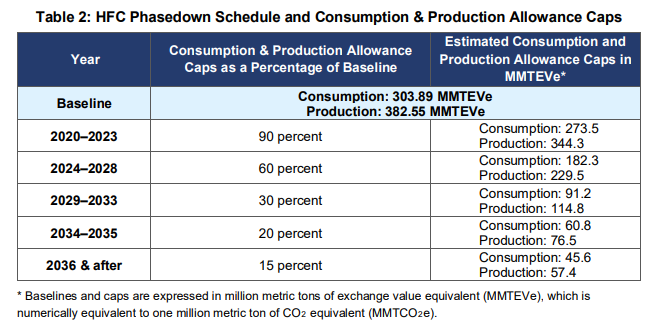On October 5, 2021, the EPA published a Final Rule in the Federal Register: “Phasedown of Hydrofluorocarbons (HFCs): Establishing the Allowance Allocation and Program under the American Innovation and Manufacturing Act” (AIM Act). The AIM Act directs the EPA to phasedown production and consumption of HFCs in the United States by 85% over the next 15 years. The effective date of this final rule is November 4, 2021.
Companies potentially affected by this rule are those that produce, import, export, destroy, use as a feedstock, reclaim, package, or otherwise distribute HFCs. Others potentially affected include those that use HFCs to manufacture products such as refrigeration and air conditioning systems, foams, aerosols, fire suppression systems, or use HFCs in one (1) of the following six (6) specific applications:
- Propellants in metered dose inhalers;
- Defense sprays (e.g., bear spray);
- Structural composite preformed polyurethane foam for marine and trailer use;
- Etching of semiconductor material or wafers and the cleaning of chemical vapor deposition chambers within the semiconductor manufacturing sector;
- Mission-critical military end uses; and
- On-board aerospace fire suppression.
The EPA will address HFC phasedown by reducing production and consumption, maximizing the reclamation of HFCs, minimizing the release of HFCs from equipment, and facilitating the transition to next-generation technologies through sector-based restrictions.
To accomplish the phasedown, the EPA is undertaking the actions listed below.
- Establishing HFC production and consumption baselines.
- The baselines are calculated using a formula provided in the AIM Act that considers past HFC, hydrochlorofluorocarbon (HCFC), and chlorofluorocarbon (CFC) amounts.
- By October 1st of each year, the “EPA must issue production and consumption allowances for the following calendar year, relative to those baselines.” The maximum number of allowances that the EPA may allocate per year is shown in Table 2 below.



